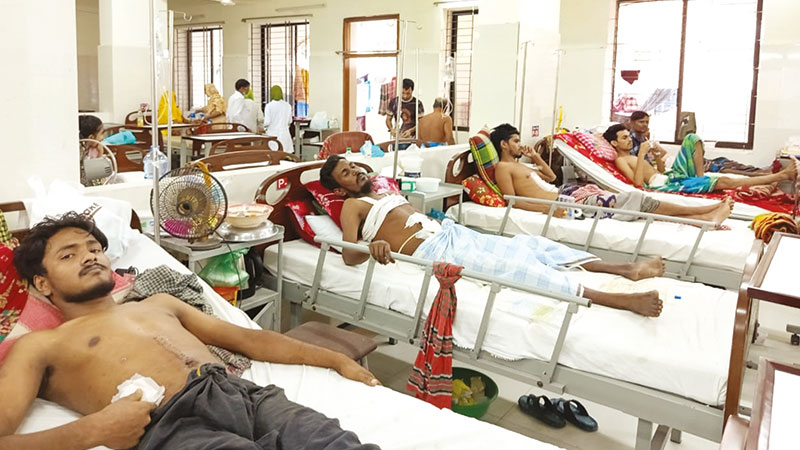Many of those injured in the agitation are still undergoing treatment at Shaheed Suhrawardy Medical College Hospital. Photo: Staff Photographer
The violent fallout from the anti-discrimination student movement and the subsequent downfall of the Awami League government has left thousands injured in the capital alone. Among them, at least three thousand had to be hospitalized. While most have been discharged after treatment, many severely injured individuals remain under medical care. A survey of six specialized public hospitals in Dhaka on Thursday (August 15) and Friday (August 16) revealed that over two hundred people injured in the protests are still hospitalized, most of them with gunshot wounds. Some are in critical condition, while others will require long-term treatment.
Abdur Rahman (not real name) used to work at a garment factory in Ashulia. He was caught in the violent clashes on August 5, the day the ruling Awami League government fell. He was shot and suffered over a hundred pellet wounds in both legs. Many of these pellet bullets remain embedded, and doctors have informed him that they cannot be removed. He has to live with the bullets in his body for the rest of his life. Rahman, currently admitted to Shaheed Suhrawardy Medical College Hospital, will need to remain under medical supervision for several more days.
According to Shaheed Suhrawardy Medical College Hospital officials, between July 18 and July 22, a total of 518 people injured during the protests received emergency treatment. Sixty-five of them were admitted. Major surgeries were conducted on 31 patients and minor surgeries on 150 others. During this period, the hospital received 21 dead bodies. In the second phase of violence, from August 4 to August 6, over 150 injured individuals sought treatment at the hospital, with 28 being admitted. Another 20 dead bodies were brought in. Currently, 41 patients from both phases remain under treatment.

At Ward 421 of the hospital, all patients are gunshot victims. Many have undergone between two and five surgeries. The admitted patients come from diverse backgrounds, including students, garment workers, day laborers, and even children.
When asked about the current situation, Dr. Md. Shafiur Rahman, the director of Shaheed Suhrawardy Medical College Hospital, told Bonik Barta, “Nearly all of the patients still under treatment are gunshot victims. Most of them are in poor financial condition. So the hospital is covering all their medical expenses. We are doing everything we can to prevent them from facing financial ruin due to medical costs. All the patients injured in the protests are being treated in the same ward.”
At Sher-e-Bangla Nagar’s National Institute of Traumatology and Orthopaedic Rehabilitation (NITOR), more than 1,500 injured patients were admitted. According to hospital sources, over 300 of these patients have gunshot wounds, 144 of whom remain under treatment. Several patients had to undergo amputations to save their lives.
Dr. Md. Badiuzzaman, the deputy director of NITOR, informed Bonik Barta, “During the protests, dead bodies of two individuals were brought to our hospital. Five others died while under treatment. Some of the current patients had to have their limbs amputated due to severe damage to arteries and veins from gunshots. The damage was so extensive that reattaching the arteries and veins was impossible. As a result, blood circulation stopped and led to gangrene. Amputation was the only option to save their lives. Many patients are still in critical condition.”
Similarly, the National Institute of Ophthalmology (NIO) reported that over 500 injured patients sought treatment during the protests over the past month. From July 18 to July 22, 395 patients with eye injuries were treated. 308 patients were admitted and 256 surgeries performed. Between August 4 and August 14, another 288 patients received treatment, with 269 admitted. 188 injured individuals had to undergo major surgeries. Currently, 30 patients are still receiving treatment at the hospital. Professor Dr. Golam Mostafa, the director of the institute, told Bonik Barta, “These patients sustained eye injuries in the clashes and violence. Patients have different types of eye injuries. Many patients have lost their eyesight. Those admitted were mainly shot in the eye with pellets, rubber bullets and live rounds. Many people have lost their eyesight due to tear gas.”

At the National Institute of Diseases of the Chest and Hospital (NIDCH), 40 patients were admitted in two phases due to injuries sustained during the protests. Two of these patients have since died. Thoracic surgeon Dr. Nazmul Islam told Bonik Barta that, “All the admitted patients were gunshot victims. Currently, seven patients are undergoing treatment. Admitted patients have various injuries with bullets hitting the chest, lungs, beneath the heart, and upper body.”
Yamin Talukder (alias), a teenager from Mirpur, was injured on August 4. According to his father, the Higher Secondary Certificate (HSC) examinee was stabbed in the neck and shot in the abdomen during the protests. The knife wound required five stitches. The bullet that hit his left abdomen passed through, saving his life. Doctors have advised that he remain in the hospital for a few more days to ensure a full recovery.
According to sources at Sir Salimullah Medical College and Mitford Hospital, the hospital received nearly 300 patients in two phases of the protests. Most of those admitted have since recovered and discharged, with five still under treatment.
Over 500 injured patients received treatment at Mugda Medical College Hospital. Dr. Hasibul Islam, the hospital’s director, told Bonik Barta, “A total of 80 patients were admitted here during the protests. Initially, six patients were brought in dead. Currently, five patients remain under treatment.”

